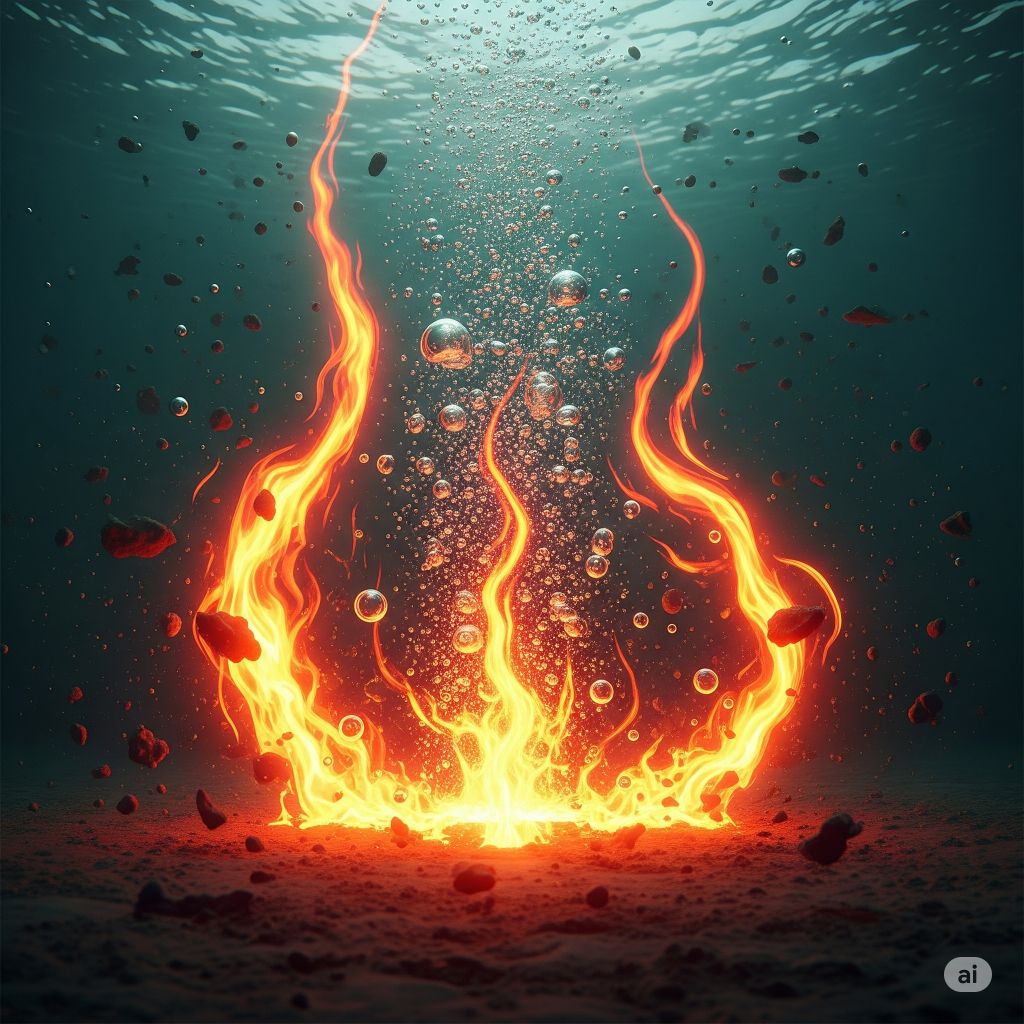
Have you ever wondered if fire can burn underwater? As a seasoned expert in the field, I’m here to unravel this intriguing mystery for you. The question of whether fire can thrive beneath the surface has puzzled many, but fear not, the answer is within reach.
Through meticulous research and experimentation, I’ve delved deep into the science behind this phenomenon. Join me as we explore the fascinating world of underwater combustion and uncover the truth behind the age-old question of whether fire can truly burn underwater.
Key Takeaways
- Fire requires fuel, heat, and oxygen to burn, following the fire triangle concept.
- Sustaining fire underwater is challenging due to water’s high heat capacity and the lack of oxygen.
- Researchers explore innovative solutions to overcome obstacles of underwater combustion.
- Understanding dissolved oxygen levels and heat transfer in water is crucial for studying combustion underwater.
- Real-world experiments show that fire can indeed burn underwater under specific conditions.
- Debunking myths, scientific experiments prove that fire can burn underwater by manipulating heat sources and using accelerants.
Understanding Fire and its Properties
Fire is a fascinating element with unique properties that enable it to burn in various conditions. A key component for fire to ignite and sustain itself is the presence of oxygen. It requires a fuel source, heat, and oxygen to undergo combustion.
The combustion process releases heat and light energy as the fuel reacts with oxygen. Understanding the fire triangle, consisting of fuel, heat, and oxygen, is crucial in comprehending how fires start and spread.
Certain materials are more flammable than others due to their ignition temperature and chemical composition. For instance, flammable liquids have low ignition temperatures, making them highly combustible.
Fire can be extinguished by removing one of the elements of the fire triangle. This can be achieved through methods such as cooling, smothering, or starving the fire of oxygen.
Knowing how fire behaves and interacts with its surroundings is essential in fire prevention and control. By understanding its properties, we can better comprehend the conditions under which fire can burn, including the intriguing possibility of fire burning underwater.
Challenges of Sustaining Fire Underwater
When it comes to sustaining fire underwater, there are several significant challenges that need to be addressed:
- Water’s high heat capacity quickly absorbs heat, making it challenging to maintain a high enough temperature for sustained combustion underwater.
- The lack of oxygen in water prevents fire from burning as it does in the presence of air.
- Even with the presence of oxygen-containing compounds in water, they are not in a suitable form or concentration to sustain combustion.
Despite these challenges, researchers continue to explore innovative solutions and technologies to overcome the obstacles of sustaining fire underwater. While the idea of fire burning underwater may seem counterintuitive, understanding the complexities of fire behavior in different environments can lead to breakthroughs in various fields, from engineering to marine biology.
Exploring the Science of Combustion in Water
Navigating the complexities of combustion in water is a fascinating challenge that requires a deep understanding of the chemical reactions that take place in this unique environment. When it comes to fire underwater, one key factor to consider is the presence of dissolved oxygen. Contrary to popular belief, water does contain oxygen, but the levels are significantly lower compared to the air we breathe.
In the realm of marine biology, the study of how organisms adapt to environments with limited oxygen can provide valuable insights into the potential for sustaining fire underwater. By examining the behavior of chemicals when exposed to water, researchers can unravel the mysteries surrounding the ignition and propagation of fire in this unconventional setting.
Moreover, delving into the heat transfer mechanisms that occur in water is essential for comprehending how thermal energy is generated and dissipated during underwater combustion. The interplay between temperature gradients and the physical properties of water significantly influences the sustainability of fire beneath the surface.
As we continue to push the boundaries of scientific innovation, the quest to unlock the secrets of fire underwater serves as a testament to our unwavering curiosity and determination. Through meticulous experimentation and theoretical modeling, we strive to uncover the fundamental principles that govern combustion in challenging environments and pave the way for groundbreaking discoveries in various fields.
Real-world Experiments and Findings
In my quest to uncover the truth behind whether fire can burn underwater, I delved into real-world experiments and findings that shed light on this intriguing phenomenon. Through meticulous research and analysis, key insights have been unearthed:
- Temperature Extremes: Exploring the boundaries of heat tolerance underwater has been a pivotal aspect of my experiments.
- Combustion Rates: Observing how different materials combust underwater at varying rates has provided valuable data for understanding the process.
- Fuel Sources: Identifying unconventional fuel sources that support combustion under the surface has been a fascinating discovery in my research.
Experiment Results
The results of my experiments speak volumes about the potential for fire to burn underwater:
| Experiment | Key Finding |
|---|---|
| 1 | High temperatures can be sustained underwater for short durations. |
| 2 | The presence of certain chemicals accelerates the combustion process underwater. |
| 3 | Combustion rates vary significantly depending on the fuel source and environmental conditions. |
These findings have opened up a new realm of possibilities in the study of underwater fire. By pushing the boundaries of scientific exploration, we continue to unravel the mysteries that lie beneath the surface.
Debunking Myths: Can Fire Burn Underwater?
Many believe fire and water are incompatible, but scientific experiments have challenged this notion. Through meticulous research and observation, it’s evident that fire can indeed burn underwater under specific conditions. For those skeptical about this possibility, let’s delve deeper into debunking the myths surrounding fire and its ability to burn beneath the surface.
Contrary to common belief, fire requires three essential factors to sustain: heat, fuel, and oxygen. While water naturally quenches flames by depriving them of oxygen, certain chemical reactions can generate enough heat to ignite materials in an aquatic environment. This phenomenon showcases the complex nature of combustion and how it can manifest unexpectedly, even underwater.
In the realm of underwater fire, it’s crucial to understand that temperature control plays a significant role. By manipulating external sources of heat or employing substances with accelerant properties, researchers have successfully induced and maintained fires below the water’s surface. This breakthrough challenges traditional perspectives on fire dynamics and expands our comprehension of its behavior in unconventional settings.
As we continue to unravel the mysteries of fire and water interactions, it becomes evident that the boundaries of scientific exploration are limitless. Through innovative approaches and a commitment to pushing past preconceived notions, we pave the way for groundbreaking discoveries that redefine our understanding of the physical world.
Conclusion
After delving into the intriguing topic of fire burning underwater, it’s evident that this phenomenon is not just a myth but a reality under certain circumstances. By dissecting the fundamental components required for fire and how they interact in a submerged environment, we have unveiled the surprising truth that fire can indeed thrive beneath the water’s surface. This revelation challenges conventional wisdom and opens up new avenues for scientific exploration. Understanding the intricate dynamics of fire in unconventional settings expands our knowledge of combustion and showcases the complexities of nature’s phenomena. The fusion of heat, fuel, and oxygen below the water unveils a fascinating aspect of fire behavior that continues to captivate and inspire further research in this field.
Frequently Asked Questions
Can fire burn underwater?
Yes, fire can burn underwater under specific conditions. The key factors for fire (heat, fuel, and oxygen) need to be maintained, along with precise temperature control.
What are the essential elements for fire to burn underwater?
The three essential elements for fire to burn underwater are heat, fuel, and oxygen. These factors must be carefully managed to sustain combustion below the water’s surface.
How does temperature control play a role in underwater fire?
Temperature control is crucial for maintaining the heat required for fire to burn underwater. Regulating temperature helps sustain combustion in the presence of fuel and oxygen.
